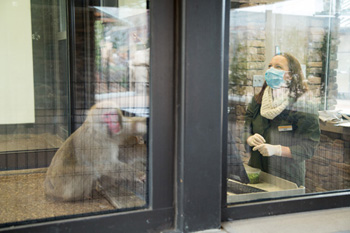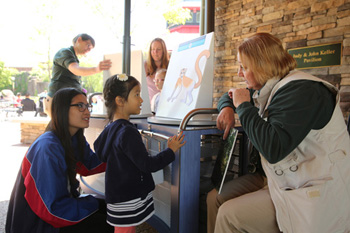April 26, 2018
“Regenstein Macaque Forest illustrates how zoos aren’t just places to look at animals, but conservation institutions that are conducting groundbreaking research. Integrating interpretive elements into exhibits help showcase how Lincoln Park Zoo is taking expert care of these animals as a result of our research.” – Allison Price, Director, Learning Experiences, Lincoln Park Zoo
Lincoln Park Zoo, a free-admission zoo open 365 days a year in Chicago, welcomed in 2015 a group of Japanese macaques to a new exhibit, Regenstein Macaque Forest. The state-of-the-art exhibit includes interpretive elements, such as a mobile learning station, a microsite, and other interactive elements, to engage visitors more deeply in the science of animal care and zoology.
With a goal of showcasing science on exhibit, Lincoln Park Zoo discussed various species that would be appropriate for a new habitat. Japanese macaques fit the profile: they are a temperate species, engaging, social, smart, and would be apt to participate in the zoo’s existing voluntary primate cognition program. The new exhibit would allow the zoo to highlight activities that typically take place "behind the scenes” at zoos.

Highlighting Cognitive Research
Highlighting the zoo’s primate cognition expertise was paramount in conceptualizing and implementing the exhibit’s interpretive elements. The zoo’s science, learning, and animal care teams worked together to create and implement a range of research programs and interpretive content. Monday through Friday, researchers and a zookeeper interact with the monkeys through the glass partition of the research kiosk, monitoring the macaques’ social behaviors as they perform different cognitive tests via interactive touchscreens. During these research activities, an educator explains the activities to the public, describing what is going on, and why it is important to an overall understanding of this species.
“These demonstrations are an opportunity to showcase young researchers in roles that aren’t just behind the scenes in a white lab coat,” said Rebecca Garrett, Foundation and Special Gifts Director at the zoo. “We are able to provide a different perspective on a career in science.”
Build a Primate

As part of the grant, the zoo designed and implemented a mobile learning station to supplement the exhibit. Themed “Build a Primate,” the station encourages visitors of all ages and learning levels to participate in an inquiry-based approach to understanding animal anatomy. It invites them to “build” a monkey adapted for a specific function or habitat.
After building the monkey, users can take photos of it and share it on social media through the exhibit’s microsite. The dedicated microsite provides more exhibit information, interactive activities, and video, for access beyond the zoo that is for anyone, anywhere, anytime.
“We wanted to provide visitors with an idea of how primates are adapted to their local environments,” said Allison Price, Learning Experiences Director at Lincoln Park Zoo. “It asks them to think about the form and function of all the body parts and how they connect to primate behavior and the ecosystem.”
Creating Connections with the Macaques

The exhibit has become a guest favorite, which the zoo attributes to guest-centric design and the connections visitors make with the monkeys.
“Fostering empathy and perspective when viewing animals was just as important as cultivating curiosity,” said Price. “If you can link people’s emotional attitudes and connection to animals to their curiosity about the species and curiosity about science and research those are indicators of possible future interest in the scientific aspects of the zoo,” said Price.
The exhibit design has also built a sense of community among zoo visitors. “People are staying longer,” said Price. “The macaque exhibit has helped us design a process of interpretive programming to engage guests going forward.”
Expanding Interpretive Programming
Since the exhibit opening, the zoo has used a similar interpretive approach at its new polar bear and African penguin exhibits, which opened in 2016. The zoo has also created an Interpretive Task Force charged with better integrating interpretive programming across the various zoo exhibits.

Designing the exhibit and interpretive elements required the zoo’s Animal Care, Learning, and Conservation & Science Departments work closely together. “We all had the same goals to increase public engagement with zoo science, build a habitat where we can monitor and promote positive welfare for this species, and offer exciting opportunities for the animals,” said Price.
The success of the interpretive programming means something much more to Lincoln Park Zoo staff. “We don’t just interpret the animals’ behavior,” said Price. “Integrating interpretive programming allows us to tell the Lincoln Park Zoo story and what we are doing to better care for and understand the animals.”
About the Project
Grant Project Name: Lincoln Park Zoo/Japanese Macaque Interpretive Exhibit
Grant Log Number: MA-10-13-0349-13
Year Awarded: 2013
Recipient: Lincoln Park Zoological Society
Project Contact:
Rebecca Garrett, Director, Foundation and Special Gifts
rgarrett@lpzoo.org
312-742-5842
Website: www.snowmonkeys.org/